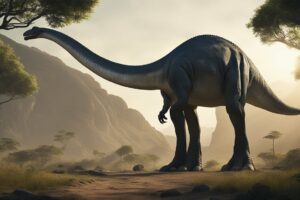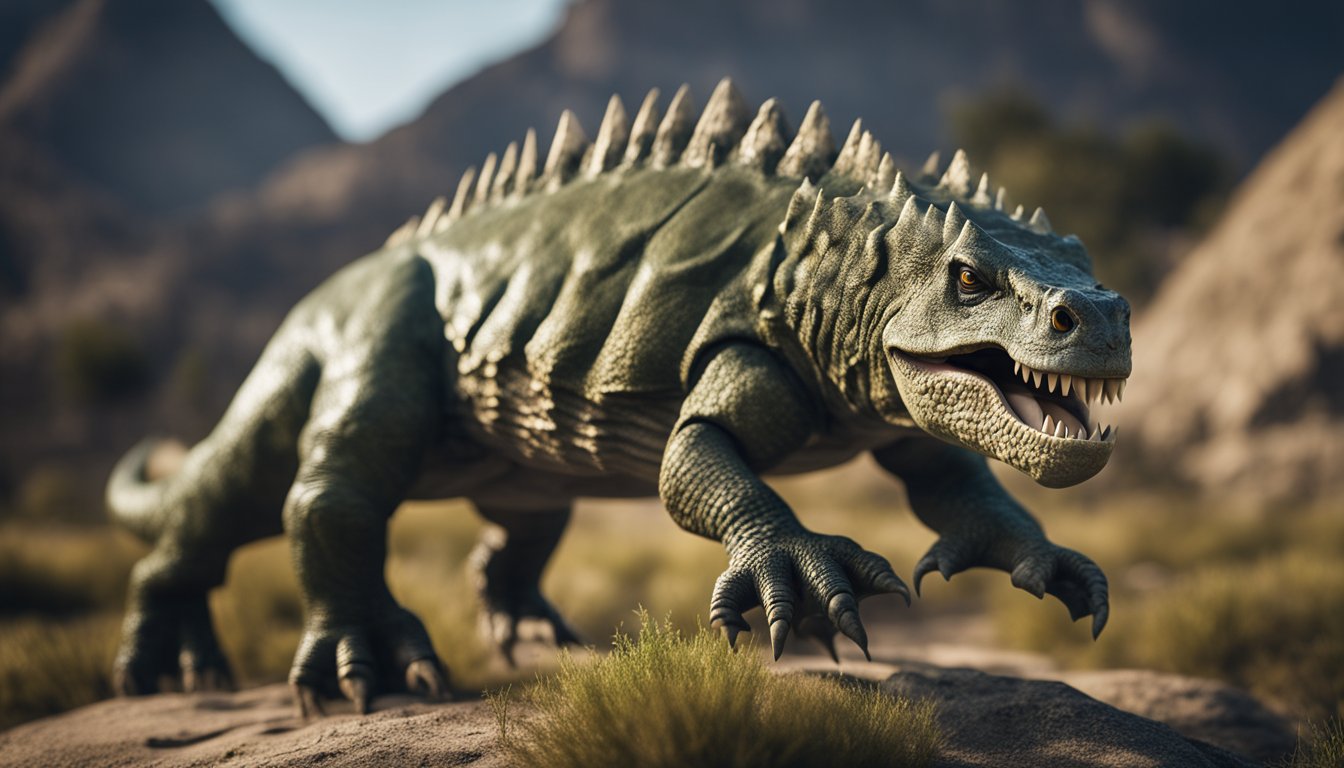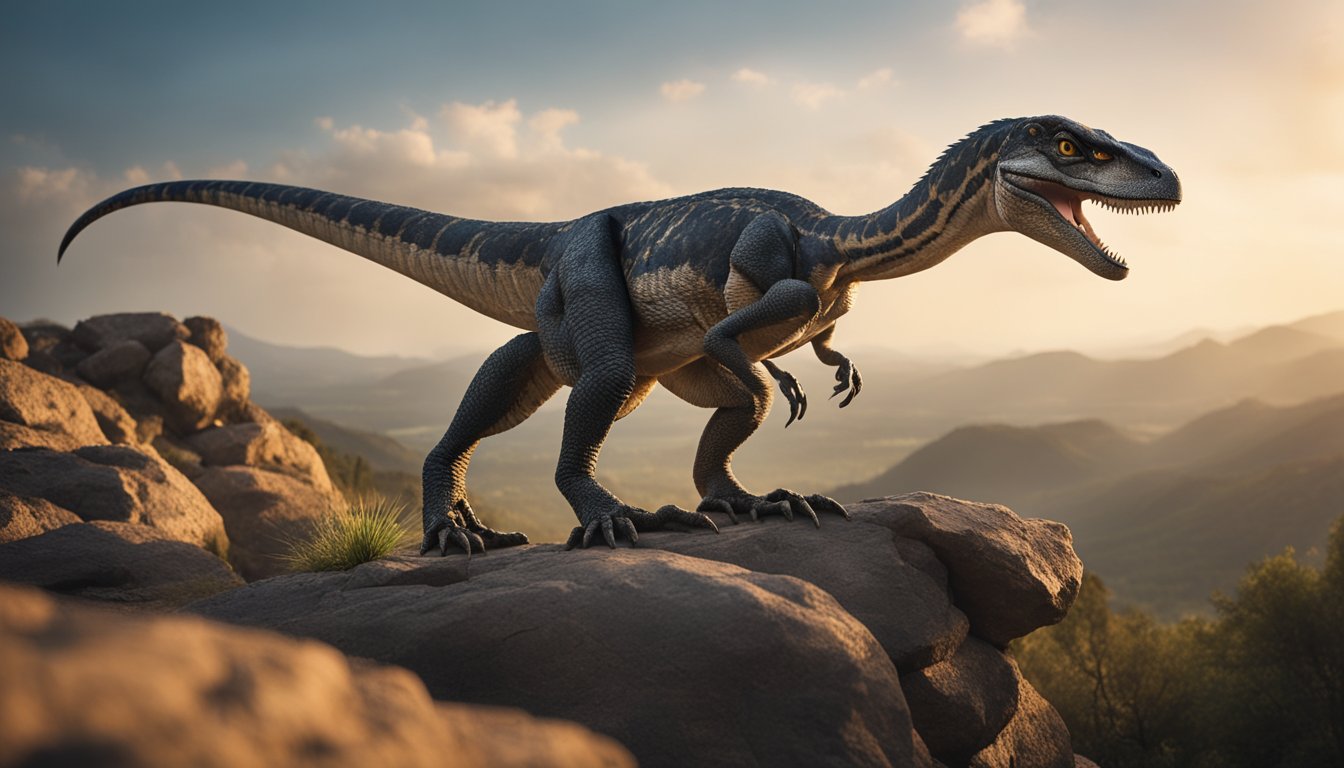Carnotaurus, the bull dinosaur with horns, was a fearsome predator that roamed the earth during the Late Cretaceous period, approximately 69-71 million years ago.
Its name, which means “meat-eating bull,” accurately describes this animal’s appearance and diet.

Carnotaurus was a large theropod dinosaur that measured up to 8 meters in length and weighed around 1.35 metric tonnes.
One of its most distinctive features was the pair of horns on the top of its head, which gave it a bull-like appearance.
Despite its size, Carnotaurus was lightly built, making it a swift and agile hunter.
Its short arms were a unique adaptation that set it apart from other large meat-eating dinosaurs.
Carnotaurus is a fascinating dinosaur that has captured the imagination of scientists and dinosaur enthusiasts alike.
Its unique physical characteristics and hunting strategies have been the subject of much study and speculation.
In this article, we will explore the world of Carnotaurus and uncover some of the amazing facts and discoveries that have been made about this remarkable creature.
Uncovering the Past: Discovery and History
Carnotaurus, the “carnivorous bull” dinosaur, has captured the imagination of paleontologists and dinosaur enthusiasts alike since its discovery in 1984.
In this section, we will explore the history of Carnotaurus, from its first discovery to the latest fossil finds in South America.
First Discovery and Naming
The story of Carnotaurus begins with the renowned Argentine paleontologist, José Bonaparte.
In 1984, Bonaparte discovered a remarkable fossil in Chubut Province, Patagonia, Argentina.
The fossil was a nearly complete skeleton of a strange-looking dinosaur with large horns on its skull.
Bonaparte named the animal Carnotaurus, which translates to “carnivorous bull,” in reference to its unique features.
Carnotaurus quickly became a sensation in the scientific community due to its unusual appearance.
The dinosaur was about 8 meters long and weighed around 1.5 tons.
Its most distinctive feature was its skull, which was short and deep, with two large horns above the eyes.
The horns were probably used for display or combat, rather than defense or predation.
Fossil Finds in South America
Since the discovery of the first Carnotaurus fossil, paleontologists have found additional specimens in South America.
Most of these fossils come from the La Colonia Formation, a geological formation that dates back to the Late Cretaceous period, around 70 million years ago.
One of the most significant Carnotaurus finds was made in 1992 by a team of paleontologists led by Rodolfo Coria.
The team discovered a nearly complete skeleton of a juvenile Carnotaurus in Patagonia, Argentina.
The fossil provided valuable insights into the growth and development of the dinosaur.
In recent years, scientists have used advanced imaging techniques to study the Carnotaurus fossils in greater detail.
For example, in 2021, researchers revealed the fossilized skin of a Carnotaurus, which was preserved along with sheets of its scaly hide.
The discovery sheds light on the appearance and texture of the dinosaur’s skin, as well as its coloration.
Overall, the discovery and study of Carnotaurus has contributed greatly to our understanding of dinosaur evolution and behavior.
The unique features of this “carnivorous bull” dinosaur continue to fascinate and inspire scientists and the public alike.
Carnotaurus Anatomy: Features and Functions

Carnotaurus was a fearsome predator that roamed the earth during the Late Cretaceous period, around 69-71 million years ago.
It was a large theropod dinosaur that could grow up to 8 meters in length and weigh around 1.3 metric tons.
The Significance of Horns
One of the most striking features of Carnotaurus is the pair of thick, conical horns above its eyes.
These horns, unlike anything seen in other carnivorous dinosaurs, hint at a complex social behavior and sexual dimorphism.
According to a study published in the journal “Science,” the horns were likely used for intraspecific combat between males, as well as for display purposes to attract mates.
Skin, Scales, and Texture
Carnotaurus had a unique skin texture, as evidenced by fossilized skin impressions found in Argentina.
The skin was covered in non-overlapping scales, similar to those of a crocodile, and had a rough, pebbly texture.
The scales were arranged in rows along the body, with larger scales on the back and smaller scales on the belly.
Unique Limbs and Locomotion
Carnotaurus had relatively short arms compared to its body size, with only two fingers on each hand.
The legs were long and muscular, with strong thigh bones and elongated foot bones.
This unique limb structure allowed Carnotaurus to run at high speeds, estimated to be around 48 km/h, making it one of the fastest theropods.
Skull Structure and Bite Force
Carnotaurus had a narrow, elongated skull with sharp, serrated teeth that were designed for slicing flesh.
The bite force of Carnotaurus was estimated to be around 3,000 pounds, making it one of the strongest bites of any known dinosaur.
In conclusion, the anatomy of Carnotaurus was uniquely adapted for hunting and survival in the Late Cretaceous ecosystem.
Its horns, skin texture, limb structure, and skull design were all finely tuned for its predatory lifestyle.
Despite going extinct millions of years ago, Carnotaurus continues to fascinate and intrigue paleontologists and dinosaur enthusiasts alike.
Fun fact: The name “Carnotaurus” means “meat-eating bull” in Latin, a nod to its fearsome appearance and predatory habits.
Lifestyle of a Predator: Diet and Hunting

Carnivorous Diet and Prey
As a predator, Carnotaurus had a strictly carnivorous diet, which means it only ate meat.
Its main prey were the large herbivorous sauropods, which were abundant during the late Cretaceous period when Carnotaurus lived.
Despite its large size, Carnotaurus had a relatively small head compared to other theropods, which suggests that it may have had a more specialized diet than other meat-eating dinosaurs.
Hunting Strategies and Behavior
Carnotaurus was a skilled hunter with a variety of hunting strategies. It had a keen sense of smell, which allowed it to detect prey from a distance.
Once it had located a potential meal, Carnotaurus would use its powerful legs to quickly close the distance and attack.
Its short arms were not useful for grasping prey, so it likely relied on its strong jaws and sharp teeth to kill and consume its meals.
Carnotaurus was also known for its speed and agility, which made it a formidable hunter.
It could run at speeds of up to 30 mph, which allowed it to quickly catch up to fleeing prey.
Additionally, it had a unique skeletal structure that allowed it to bend its spine in a way that gave it more flexibility when hunting.
Overall, Carnotaurus was a skilled and adaptable hunter with a variety of strategies for catching its prey.
Its feeding habits were likely similar to other theropods, which involved tearing off chunks of flesh and swallowing them whole.
Carnotaurus in Context: Environment and Evolution

Late Cretaceous Ecosystem
Carnotaurus lived during the Late Cretaceous period, around 70 million years ago.
During this time, the Earth was much warmer than it is today, and the continents were arranged differently.
South America was still connected to Antarctica, India was an island, and North America was split in half by a shallow sea.
The climate was tropical, and the landscape was dominated by forests, rivers, and swamps.
Carnotaurus inhabited Gondwana, a supercontinent that included modern-day South America, Africa, Antarctica, India, and Australia.
It lived in what is now Argentina, in the Maastrichtian stage of the Late Cretaceous.
This was a time of great change, as many species of dinosaurs were going extinct, and new ones were evolving.
Evolutionary Relatives and Diversity
Carnotaurus was a theropod, a group of bipedal, carnivorous dinosaurs that includes the famous Tyrannosaurus rex.
However, Carnotaurus was not closely related to T. rex, but instead belonged to a group called the Abelisauridae.
This group of theropods was unique to the southern continents of Gondwana, and included many bizarre and unusual species.
Carnotaurus was one of the most distinctive members of the Abelisauridae, with its bull-like horns and short, stubby arms.
It was also one of the largest, reaching lengths of up to 8 meters (26 feet) and weighing as much as 1.5 tons.
Other members of the Abelisauridae included Aucausaurus, Majungasaurus, and Giganotosaurus, some of which were even larger than Carnotaurus.
Despite their diversity, the Abelisauridae were all well-adapted to life in the Late Cretaceous ecosystem.
They were fierce predators, with sharp teeth and powerful jaws, and were able to take down large herbivorous dinosaurs like the titanosaurs.
However, as the Late Cretaceous drew to a close, the Abelisauridae, along with many other dinosaur groups, went extinct, leaving only their fossil remains to tell the story of their incredible evolution and adaptation.
Frequently Asked Questions

What distinguishes the Carnotaurus from other horned dinosaurs?
The Carnotaurus is a unique dinosaur that is easily recognizable due to its bull-like horns.
Unlike other horned dinosaurs, the horns of the Carnotaurus are not located on the top of its head.
Instead, they are situated just above its eyes, giving it a distinctive appearance.
Additionally, the Carnotaurus is known for its short, muscular neck and its powerful hind legs, which made it an incredibly fast runner.
How did the Carnotaurus use its horns in the wild?
The exact purpose of the Carnotaurus’s horns is still a topic of debate among scientists.
Some believe that the horns were used for defense against predators, while others think that they may have been used for display purposes to attract mates.
Another theory suggests that the horns were used in combat between rival males during mating season.
What can the size and structure of Carnotaurus tell us about its lifestyle?
Based on its size and structure, scientists believe that the Carnotaurus was a fierce predator that hunted other dinosaurs for food.
Its powerful hind legs allowed it to run at incredibly high speeds, making it an efficient hunter.
Additionally, its short neck and small arms suggest that it used its powerful jaws to kill its prey.
What are the unique features of the Carnotaurus skeleton?
The Carnotaurus had a number of unique features that set it apart from other dinosaurs.
For example, its skull was incredibly narrow and elongated, which allowed it to deliver powerful bites to its prey.
Additionally, its arms were incredibly small and weak, which suggests that they were not used for hunting or defense.
How fast could a Carnotaurus run, and how did this benefit it?
The Carnotaurus was one of the fastest dinosaurs that ever lived, with some estimates suggesting that it could run at speeds of up to 30 miles per hour.
This speed was a key advantage when hunting prey, as it allowed the Carnotaurus to catch even the fastest dinosaurs.
What theories exist about the extinction of the Carnotaurus?
Like many dinosaurs, the exact cause of the Carnotaurus’s extinction is still unknown.
However, some scientists believe that the extinction of the dinosaurs was caused by a catastrophic event, such as an asteroid impact or a massive volcanic eruption.
Other theories suggest that the dinosaurs may have slowly died out due to changes in the climate or competition from other animals.





